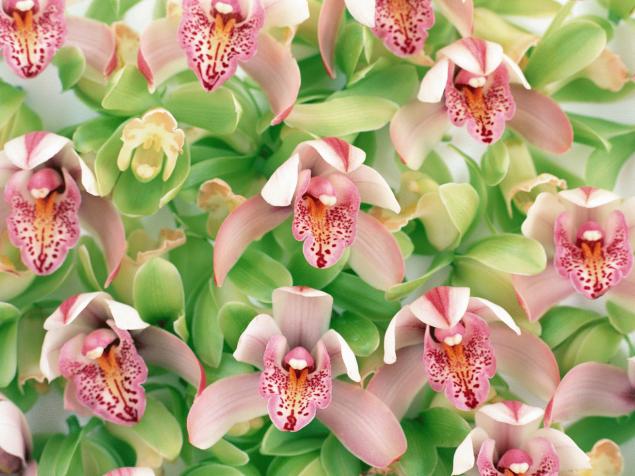How to care for orchids?
 Bashny.Net
Bashny.Net
The Golden rule of success in growing orchids is to duplicate as closely as possible their natural growing conditions. In nature, most orchids are epiphytes, meaning they grow on other objects, clinging to the bark or even stone. Showy orchids, mostly preferred by most of the people are usually either Phalaenopsis hybrid or hybrid dendrobiums.

These plants thrive under the following conditions: bright light but not direct afternoon sunlight (although Dendrobium can handle more sun) high humidity, air movement around the roots regular periods of drying, alternating with periods of wetting, temperature from 10 to 30 degrees Celsius. What you have created, the conditions will be listed closer to the you expect more success and better blooms.

Most orchids bought in shops, contained in plastic pots with the roots covered with damp moss. Obviously, this violates two rules of successful growing of orchids. There is no movement of air around the roots, and the roots are not given a chance to dry completely. Thus, the plant cannot breathe and inevitably it will rot the roots. The root system of orchids is a highly specialized organ designed for fast wicking and breathing. It is not designed to extract nutrients from the soil.

The first thing you should do with any store-bought Orchid is to enjoy the bloom. Do not attempt to repot a flowering plant. After flowering, you can cut off with sterile scissors spike and repot the plant. Orchids are transplanted in specialized pots for orchids and a special blend.

Pots for orchids can be recognized by a wide drainage holes at the base through which the water literally runs out of pot. They are always available. A mix for growing orchids always made up of several ingredients, including pine bark, charcoal, and even Styrofoam. Care of Orchid plants is very simple.

During the summer months, abundantly watered them every week. Allow the water to soak the roots and drain on a tray with pebbles (this will create more moisture) And the plant does not hurt if you take it over to the kitchen sink and really soak the roots. Don't worry, you won't kill him if will allow the roots to dry out.

During the growing season, fertilize weekly with liquid fertilizer soluble. During the winter, keep your plant warm and cut the frequency of watering to once per month. Spray. But do not make fertilizer.
Source: /users/117

These plants thrive under the following conditions: bright light but not direct afternoon sunlight (although Dendrobium can handle more sun) high humidity, air movement around the roots regular periods of drying, alternating with periods of wetting, temperature from 10 to 30 degrees Celsius. What you have created, the conditions will be listed closer to the you expect more success and better blooms.

Most orchids bought in shops, contained in plastic pots with the roots covered with damp moss. Obviously, this violates two rules of successful growing of orchids. There is no movement of air around the roots, and the roots are not given a chance to dry completely. Thus, the plant cannot breathe and inevitably it will rot the roots. The root system of orchids is a highly specialized organ designed for fast wicking and breathing. It is not designed to extract nutrients from the soil.

The first thing you should do with any store-bought Orchid is to enjoy the bloom. Do not attempt to repot a flowering plant. After flowering, you can cut off with sterile scissors spike and repot the plant. Orchids are transplanted in specialized pots for orchids and a special blend.

Pots for orchids can be recognized by a wide drainage holes at the base through which the water literally runs out of pot. They are always available. A mix for growing orchids always made up of several ingredients, including pine bark, charcoal, and even Styrofoam. Care of Orchid plants is very simple.

During the summer months, abundantly watered them every week. Allow the water to soak the roots and drain on a tray with pebbles (this will create more moisture) And the plant does not hurt if you take it over to the kitchen sink and really soak the roots. Don't worry, you won't kill him if will allow the roots to dry out.

During the growing season, fertilize weekly with liquid fertilizer soluble. During the winter, keep your plant warm and cut the frequency of watering to once per month. Spray. But do not make fertilizer.
Source: /users/117
Tags
diseases and protection of plants
Orchid
rastia
vases
vases in the house
growing orchids
natural growing conditions
bright light
high humidity
air movement around the roots
plastic flower pots
flowering orchids
See also
How to care for plum
Ginger — root and youth: how to plant and how to care
How to protect plants from the return of frost
How to grow bonsai?
To defeat the pests, it is necessary to listen to the plants
Environmental pots for plants

















